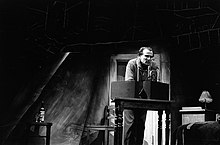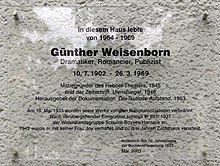Günther Weisenborn
Günther Weisenborn (born July 10, 1902 in Velbert , † March 26, 1969 in Berlin ) was a German writer and resistance fighter .
Life
Weisenborn grew up in Opladen and was a freelancer for the Opladener Zeitung in the early 1920s . After completing his German and medical studies in Cologne, Bonn and Berlin in 1927, he initially worked as an actor at various theaters and in 1928 became a dramaturge at the Berliner Volksbühne , where on October 16, 1928 his anti-war play U-Boot S4 , directed by Leo Reuss was premiered. Together with Robert Adolf Stemmle he wrote the text for the "proletarian ballad" Mann im Beton , set to music by Walter Gronostay in 1932 .

After the takeover of the Nazis his books were banned, but he could (under the pseudonyms W. Bohr , Christian Munk and Eberhard foresters continue to write). After a brief emigration to the USA in 1936, he returned to Germany at the end of 1937 and led a double life there: on the one hand, he was part of the National Socialist cultural scene (since 1941 dramaturge at the Schillertheater ), on the other hand, he supported the resistance organization Rote Kapelle . In 1941 he married Margarete Schnabel (1914-2004), called "Joy", whom he met in 1939 as a flatmate of Libertas and Harro Schulze-Boysen . He was involved in establishing a connection with the foreign leadership of the KPD in Switzerland. He was aware of the radio communications of some members of the illegal group with Soviet organs and provided them with reports and information.
Imprisoned by the Gestapo in Prinz-Albrecht-Strasse since September 1942 , Weisenborn was sentenced to death by the Reich Court Martial in 1943 for high treason . In the short story The Testimony (contained in Memorial , 1948), he described solitary confinement and his attempt to persuade a fellow prisoner to withdraw an incriminating testimony. The sentence was eventually reduced to a prison sentence . Today the permanent exhibition Topography of Terror commemorates Weisenborn's imprisonment in Berlin.
In April 1945 the Red Army freed Weisenborn from Luckau prison . Shortly afterwards, he was appointed mayor of nearby Langengrassau (today the Heideblick municipality ) by the Soviet occupying power .
In October 1947 he co-organized the First German Writers' Congress. After returning to West Berlin , he founded the Hebbel Theater together with Karlheinz Martin , was co-editor of the satirical magazine Ulenspiegel from 1945 to 1947 and co-founder of Studio 46 , which opened in 1946 with the world premiere of his drama Die Illegalen , in which he gained his experience had processed in the resistance.
In this regard, he initiated a process against the chief prosecutor of the Red Orchestra, Manfred Roeder , in 1947 together with Adolf Grimme and Greta Kuckhoff . These proceedings were dragged off by the Lüneburg public prosecutor's office, which was burdened with Nazism, and then discontinued in the late 1960s.
From 1951 to 1953 Günther Weisenborn worked as chief dramaturge at the Hamburger Kammerspiele and in 1953 published the book Der Lautlose Aufstand, the first comprehensive documentary report on the German resistance. Lecture tours have taken him to Asia ( Burma , the PR China , India , the USSR ) as well as to London , Paris , Prague and Warsaw . Günther Weisenborn was repeatedly committed as a pacifist against the rearmament of the Federal Republic of Germany and warned of the nuclear threat. In 1955 he wrote the screenplay for Falk Harnack's film July 20 . For this work he received the Federal Film Prize in silver. Also in 1955, he donated the Silver Leaf award, which the Dramatiker Union gave exclusively to non-members, for "personalities [...] who have made a special contribution to promoting contemporary dramatic creation".
His later work for the film includes documentaries of the resistance in the Third Reich , but also the script for Wolfgang Staudte's film adaptation of Bertolt Brecht's The Threepenny Opera . From 1964 he lived in West Berlin .
It was his wish to find rest in an urn grave in the Agarone cemetery . His wife Joy had lived in Agarone since his death.
Weisenborn's son Christian Weisenborn (* 1947) is a documentary filmmaker. He made the films Verräterkinder and Die gute Feinde , which tells the story of his father and the “Red Orchestra”, among others .
Memberships and honors
On October 6, 1969, Weisenborn was posthumously awarded the Order of the Patriotic War, First Degree, by the Presidium of the Supreme Soviet of the USSR .
Günther Weisenborn was chairman of the Association of German Authors , a member of the Free Academy of the Arts in Hamburg, the German Academy of Performing Arts, which was then based in Frankfurt am Main , and a corresponding member of the German Academy of the Arts, which was then based in East Berlin , the PEN- Clubs and the European Writers' Association Comes . He received the prize of the Académie des Hespérides .
In his hometown Velbert and in Leverkusen , street names remind of him.
Works
- Submarine S4 (Drama 1928)
- Barbarians (novel 1931)
- with Richard Huelsenbeck : Why does Frau Balsam laugh? (Drama 1932)
- Die Neuberin (play 1934, together with Eberhard Keindorff )
- The girl from Fanö (novel 1935, filmed in 1941)
- Die Furie , Roman, 1937, new edition Piper, Munich 1948; again Steidl, Göttingen 1998, ISBN 3-88243-550-X (= library of novels , 3)
- Hunch (poem 1942, written in Moabit prison)
- With Joy Weisenborn: "When we are finally free." Letters, songs, receipts 1942–1945. 1984
- Adult new edition, with an introduction by Hermann Vinke . Edited by Elisabeth Raabe. Arche, Zurich 2008, ISBN 978-3-7160-2378-5
- The illegals. Drama from the German resistance movement . 1946
- Memorial. Autobiography, 1948, in it: Preface for those born afterwards and The Statement (in French: Mémorial. Paris 1950) New edition in Verbrecher Verlag 2019, edited by Carsten Ramm, ISBN 978-3-95732-376-7
- Two men (1949, published in Tausend Gramm Ed. Wolfgang Weyrauch )
- Three Honorable Gentlemen (1951)
- L'art dramatique allemand. Quelques explications. In: Zs. L'Allemagne d'aujourdhui. Vol. 1, no. 5, July 1953, p. 532 f.
- The silent uprising (1953), on the resistance against National Socialism (based on the material collected by Ricarda Huch ), second duplicated and distributed edition (1954), various new editions: Röderberg, Frankfurt am Main 1991, ISBN 3-87682-022- 7 (= library of resistance ); French translation by Raymond Prunier: Une Allemagne contre Hitler , Félin, Paris 2000, ISBN 978-2-86645-653-5 .
- The Third Look (1956)
- The pursuer (1961)
- A giant stands up on the Yangtze. Notebook from China (1961)
- The split horizon. Writing down an outsider (1965)
- An Indifferent Wednesday (1967)
- Joy Weisenborn and Günther Weisenborn .: Love in times of high treason: Diaries and letters from prison 1942–1945. Edited by Christian Weisenborn, Sebastian Weisenborn and Hans Woller. CH Beck, Munich 2017, ISBN 978-3-406-71422-1 ( reading sample ).
- If you are human, you are also vulnerable. A reader . Edited by Carsten Ramm. Verbrecher Verlag, Berlin 2019, ISBN 978-3-95732-377-4
Radio plays
- 1957: Heron Hunter - Director: Werner Stewe ( Broadcasting of the GDR )
- 1958: Yang-Tse-Kiang - Director: Werner Stewe (Broadcasting of the GDR)
literature
- Hans-Peter Rüsing: The Drama of Resistance: Günther Weisenborn, July 20, 1944 and the Red Orchestra. Lang, Frankfurt am Main a. a. 2013, ISBN 978-3-631-62798-3 , eBook ISBN 978-3-653-02833-1 .
- Manfred Demmer: Searching for traces: The anti-fascist writer Günther Weisenborn. Leverkusen Cultural Association, 2004, DNB 971895872 .
- Mingyi Yuan: Between dramatic ballads and documentary theater: plays by Günter Weisenborn . With a foreword by Volker Klotz. Röhrig, Sankt Ingbert 2002, ISBN 3-86110-304-4 (also dissertation at the University of Stuttgart 2001).
- Roswita Schwarz: From Expressionist Awakening to Inner Emigration. Günther Weisenborn's ideological and artistic development in the Weimar Republic and in the 3rd Reich. Lang, Frankfurt am Main 1995, ISBN 3-631-47889-5 (also dissertation at the University of Mainz 1995).
- Hans Coppi , Jürgen Danyel, Johannes Tuchel : The Red Orchestra in the resistance against Hitler. Writings from the German Resistance Memorial Center . Hentrich, Berlin 1994, ISBN 3-89468-110-1 .
- Gert Rosiejka: The Red Chapel. "Treason" as an anti-fascist resistance. Results, Hamburg 1986, ISBN 3-925622-16-0 .
- René Wintzen: Rencontre avec GW: Un Portrait. In: Zs. Documents. Revue mensuelle des questions allemandes. Ed .: Bureau international de liaison et de documentation, H. 7, July 1953, pp. 662–668.
Web links
- Literature by and about Günther Weisenborn in the catalog of the German National Library
- Günther Weisenborn in the Internet Movie Database (English)
- Günther-Weisenborn-Archive in the archive of the Academy of Arts, Berlin
- Günther and Joy Weisenborn at friedenau-netzwerk.de
Individual evidence
- ↑ a b Neues Deutschland , December 23, 1969, p. 5. Online archive
- ^ Günther Weisenborn, writer. ( Memento of the original from December 24, 2013 in the Internet Archive ) Info: The archive link was inserted automatically and has not yet been checked. Please check the original and archive link according to the instructions and then remove this notice. On ticinarte.ch . Last accessed on December 21, 2013.
- ↑ Your parents fought against Hitler , Der Tagesspiegel, July 14, 2014
- ↑ My Father's Legacy , Der Tagesspiegel, July 27, 2017
- ↑ Neues Deutschland , December 23, 1969, pp. 1, 2 and 5. Online archive
- ↑ beck.de: Published on August 29, 2017
- ↑ This Zs. Was the first in France after 1945 to report on the internal German resistance to National Socialism: Issue 4, April 1947, Document N ° 26-29.
| personal data | |
|---|---|
| SURNAME | Weisenborn, Günther |
| ALTERNATIVE NAMES | Bohr, W. (pseudonym); Munk, Christian (pseudonym); Förster, Eberhard (pseudonym) |
| BRIEF DESCRIPTION | German writer and dramaturge |
| DATE OF BIRTH | July 10, 1902 |
| PLACE OF BIRTH | Velbert |
| DATE OF DEATH | March 26, 1969 |
| Place of death | West Berlin |


